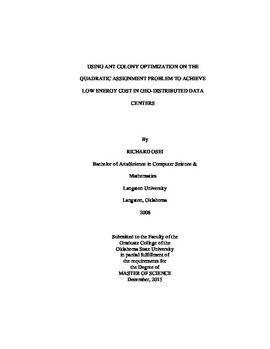| dc.description.abstract | There are many problems associated with operating a data center. Some of these problems include data security, system performance, increasing infrastructure complexity, increasing storage utilization, keeping up with data growth, and increasing energy costs. Energy cost differs by location, and at most locations fluctuates over time. The rising cost of energy makes it harder for data centers to function properly and provide a good quality of service. With reduced energy cost, data centers will have longer lasting servers/equipment, higher availability of resources, better quality of service, a greener environment, and reduced service and software costs for consumers. Some of the ways that data centers have tried to using to reduce energy costs include dynamically switching on and off servers based on the number of users and some predefined conditions, the use of environmental monitoring sensors, and the use of dynamic voltage and frequency scaling (DVFS), which enables processors to run at different combinations of frequencies with voltages to reduce energy cost. This thesis presents another method by which energy cost at data centers could be reduced. This method involves the use of Ant Colony Optimization (ACO) on a Quadratic Assignment Problem (QAP) in assigning user request to servers in geo-distributed data centers.In this paper, an effort to reduce data center energy cost involves the use of front portals, which handle users� requests, were used as ants to find cost effective ways to assign users requests to a server in heterogeneous geo-distributed data centers. The simulation results indicate that the ACO for Optimal Server Activation and Task Placement algorithm reduces energy cost on a small and large number of users� requests in a geo-distributed data center and its performance increases as the input data grows. In a simulation with 3 geo-distributed data centers, and user�s resource request ranging from 25,000 to 25,000,000, the ACO algorithm was able to reduce energy cost on an average of $.70 per second. The ACO for Optimal Server Activation and Task Placement algorithm has proven to work as an alternative or improvement in reducing energy cost in geo-distributed data centers. | |
